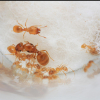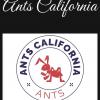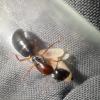Pheidole dentigula
Pheidole dentigula is one of the smallest Pheidole in North America, with queens measuring in at about 3-3.5 millimeters in length. They are most prominent in Florida and in the areas in other states that border Florida. Their invasive competitor, Pheidole navigans, has spread to occupy most of dentigula's territory in recent years and apparently tends to suppress their populations as well. It seems that an absolutely thriving dentigula population would rely on the local absence of navigans.
This photo shows approximately the size difference between one of the US' larger Pheidole, P. obscurithorax (similar in size to a queen of Solenopsis invicta or Tetramorium immigrans) and the tiny Pheidole dentigula.

June 3, 2020
On the morning of June 3, I found a single Pheidole dentigula queen in a pool. They have nuptial flights in early morning hours, and I am usually able to attract a couple of unmated dentigula queens to my lights in the morning. Up until this point I've yet to have a mated queen of them and have never raised a colony.
She shed three of her wings and left the last one dangling for about a week, before finally shedding it. She had a small batch of eggs by the third day.

June 21, 2020
After more than two weeks, the first larva arrived.


July 10, 2020
Now, she has a pupa which is getting ready to hatch into her first nanitic. Clearly it will be her only worker for a long time, as the founding process has not gone very smoothly for this queen. I think she only has one or two other small larvae. In the event that she has serious trouble getting her colony started, I will brood-boost her with Pheidole navigans brood, which would hopefully work fine. I've done that with an infertile dentigula queen I had in the past and there were no issues with acceptance. P. dentigula is so uncommon around me that I have never seen a colony of them in the wild (navigans dominates the woods around here), so it's not like I can just walk out into the woods and easily get dentigula brood for them.

Edited by Aaron567, November 1 2020 - 11:15 AM.



























